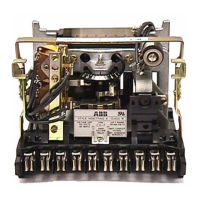
Do you have a question about the ABB CV Series and is the answer not in the manual?
| Output | SPDT, DPDT |
|---|---|
| Terminal Type | Screw Terminals |
| Mounting | DIN Rail |
| Electrical Life | 100, 000 operations |
| Mechanical Life | 10, 000, 000 operations |
Safety classification for nuclear power station equipment essential for emergency shutdown and containment.
Single-phase induction-disc relays used for voltage fault detection and timing operations.
Consist of voltage unit, auxiliary telephone relay, and indicating contactor switch.
Includes a capacitor tuned with the main coil for harmonic response.
Induction-disc principle using shaded coil for contact opening torque.
Operates similarly to overvoltage unit but with shading coil on opposite leg.
Small clapper type device attracting armature to close contacts upon energization.
Available with specific continuous voltage ratings for 2-minute duty.
Available in specific voltage ranges with multiple tap settings.
Minimum voltage required for the relay contacts to just close.
Undervoltage relays open contacts on voltage increase; overvoltage relays close contacts on voltage increase.
Voltage at which the stationary front contact of the relay closes.
Moving contact connects to back contact for voltages below tap value.
Moving contact connects to front contact for voltages above tap value.
Details power consumption for 48Vdc and 125Vdc operations.
Specifies pick up and drop out times for the auxiliary relay.
Defines the current and resistive ratings for the auxiliary relay contacts.
Main contacts close 30A at 250Vdc; seal-in contacts carry current to trip breaker.
Lists ampere pickup and DC resistance for ICS or Indicator Coils.
Details 60 Hz burdens, power factor, and watts for various relays.
Lists 50 Hz and 60 Hz burdens for CV-8 relays at continuous voltage.
Defines CV unit settings by tap setting and time dial or specific operation time.
CV-8 pickup setting adjusted by restraint spring or resistor.
Adjusts CV unit contacts for minimum opening time for circuit breaker reclosing.
No settings are required for the ICS or Trip Indicator (OI) units.
Mount relays vertically on panels, free from dirt, moisture, vibration, and heat.
Use washers for grounding and ensure good electrical connection to the panel.
Recommended check to verify the relay is in proper working order.
Checks contact alignment and follow-on for correct operation.
Verifies ICS contacts close at rated current and target drops freely.
Verifies OI operates correctly at rated current and target drops freely.
Inspect relays annually or as needed, checking time of operation.
Periodically clean contacts using recommended burnisher, avoid abrasives.
Calibrates CV unit contacts and minimum trip voltage using test circuits and Table 1.
Adjust spring tension for tap value voltage plus/minus 1% for specific relay types.
Adjust spring tension for tap value voltage minus/plus 1% for specific relay types.
Adjust control spring for closing at 8.2% and backstop at 7.8% of continuous voltage.
Calibrate operating time by adjusting permanent magnet gap or keeper per Table 1.
Adjust stationary contacts for simultaneous make and 1/64" to 3/64" wipe.
Ensure target drops with contacts or slightly ahead; adjust tab if needed.
Adjust leaf springs for pickup at 98% and no pickup at 85% of rating.
Check target drop with armature/core residual pin gap not less than 1/64".
Adjust leaf springs for pickup at 98% and no pickup at 85% of rating.
Factory repair recommended; interchangeable parts available for equipped customers.
